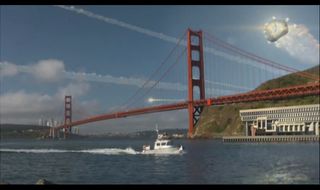
Homer Hickam: The Science Behind 'Crater Trueblood' (Op-Ed)

Homer Hickam is The New York Times No. 1 best-selling author of "Rocket Boys" — also known as "October Sky" (Dell Publishing, 2000) following the book's adaptation to film — and the "Helium-3" novels "Crater" (Thomas Nelson, 2012), "Crescent" (Thomas Nelson, 2013) "Crater Trueblood and The Lunar Rescue Company" (Thomas Nelson, 2014), as well as a retired NASA engineer. He contributed this article to Space.com's Expert Voices: Op-Ed & Insights.
Coalwood, West Virginia, is the little coal-mining town where I grew up, and it was there that five other teenage boys and I famously built and launched rockets. I recounted this story in my memoir, "Rocket Boys."
The mining towns I describe in the "Helium-3" novel series are not unlike Coalwood, but there is one major difference: Those towns, rather than being located in the Appalachian coalfields, are on the moon.
When the moon was first visited in 1969, the astronauts brought back a treasure trove of unique minerals. Contained within specimens was an isotope called Helium-3, which turns out to be the perfect fuel for fusion reactors. Although fusion reactors aren't commercial today, I believe that, eventually, thousands of people will make their living mining Helium-3 — and they will make their homes on the moon.
At the beginning of the series, in the novel titled "Crater," I write about Crater Trueblood, an orphan boy who lives in such a lunar mining town. Despite being only 14 years old, Crater is already an experienced "Heel-3" miner — since there are no child labor laws on the moon in the 22nd Century. During the course of the first novel, readers learn about the techniques and equipment used on the lunar mining "scrapes" and also the hazards of a Heel-3 convoy traveling across the lunar terrain during the first stages of an undeclared war. Here, Crater meets and fights the Crowhoppers, bioengineered warriors born to kill and die for anyone willing to pay for their services.
Such bioengineering is not science fiction, since humanity will soon be capable of giving newborns certain desirable (or possibly undesirable) physical and mental characteristics. In the novels, Crater interacts with the Umlaps, surly humans born to only do physical labor; the aforementioned Crowhoppers; and the Helpers, who are low-intelligence servants. He also goes everywhere with his "gillie," a computer made from slime mold, a simple form of life that today's researchers are studying with great interest since it seems capable of reason and logic despite its simplicity.
A scientific mystery explored in the second novel, "Crescent," has to do with the baffling lights and movement on the moon that modern astronomers call lunar transient phenomena, or LTP. Medieval monks and the ancient Chinese also observed LTP and assumed dragons were spitting fire on the moon. To this day, such sightings have continued, which means something odd is happening up there. [Lunar Flash Mystery Solved: Moon Just Passing Gas]
Get the Space.com Newsletter
Breaking space news, the latest updates on rocket launches, skywatching events and more!
I bring my own interpretation of LTP in "Crescent." (The name "Crescent" refers to a Crowhopper warrior, the only female of her species.) In the novel, Crescent and Crater go on the run, and we learn more about Armstrong City, the mercantile center of the moon where the economies of the Earth and moon intertwine. When war comes to the moon and Armstrong City is devastated, Crater, Crescent and Crater's sometimes-girlfriend Maria Medaris, who also happens to be the richest woman on the moon — along with some other hardy pioneers — escape into the Big Suck (the vacuum of the moon), in a desperate attempt to reach Alphonsus Crater. There, a ghost town awaits, the previous residents scared off by weird emanations of LTP. ['Crater Trueblood' (US 2014): Book Excerpt (Op-Ed )]
"The Lunar Rescue Company," the third novel of the trilogy, takes place seven years after the first novel. Over the course of the novels, readers watch Crater grow from a relatively innocent teen to an adult who has been betrayed by nearly everyone he trusts and loves while still maintaining a hard-won optimism. Unfortunately, his dreams of settling down with the love of his life, the fabulously rich Maria Medaris, are thwarted, mostly by Maria herself. In "Company," Crater must nonetheless rescue Maria from more bioengineered beings, the Trainers, who want to steal the Medaris empire.
During the telling of this tale, readers are introduced to fusion-driven spaceships, giant liquid telescopes, and myriad other technologies and scientific concepts. The novel opens with Maria supervising the construction of a liquid mirror telescope for her company on the far side of the moon. My decision to present a liquid mirror telescope arose because I was intrigued by its relative simplicity compared to "hard" mirrors — unfortunately, it's soon destroyed by a deliberately aimed asteroid, and Maria is subsequently kidnapped.

Crater goes after her to L-5, a location in space called a Lagrange point. Here, gravity is balanced among the Earth, the moon and the sun and where, once entered, a spaceship or asteroid will stay forever unless deliberately moved. To reach L-5, Crater uses a ship called a "fuser," which uses fusion energy. Such fusion-energy ships have many advantages over chemical rockets and are vastly faster and more efficient. At L-5, Crater finds an asteroid horde, manipulated by the Trainers for nefarious purposes, and then it is up to him and his friends to rescue Maria and, while they're at it, the entire world.
My purpose in writing these novels was to not only tell exciting tales of the future, but also to sneak in a little scientific knowledge while also demonstrating through the actions of the characters the importance of duty, honor and responsibility — a message I confess is aimed at young readers. At the end of the trilogy, there are wonderful possibilities, borne of tragedy, for Crater and his friends that could very well move humankind to the stars. On the moon, they build nothing less than a near-light-speed ship. Where that ship will take them is only limited by their (and readers') imaginations!
The author's most recent Op-Ed was "Let's Make Apollo Landing Sites American Territory." The views expressed are those of the author and do not necessarily reflect the views of the publisher. This article was originally published on Space.com.
Join our Space Forums to keep talking space on the latest missions, night sky and more! And if you have a news tip, correction or comment, let us know at: community@space.com.
Most Popular

